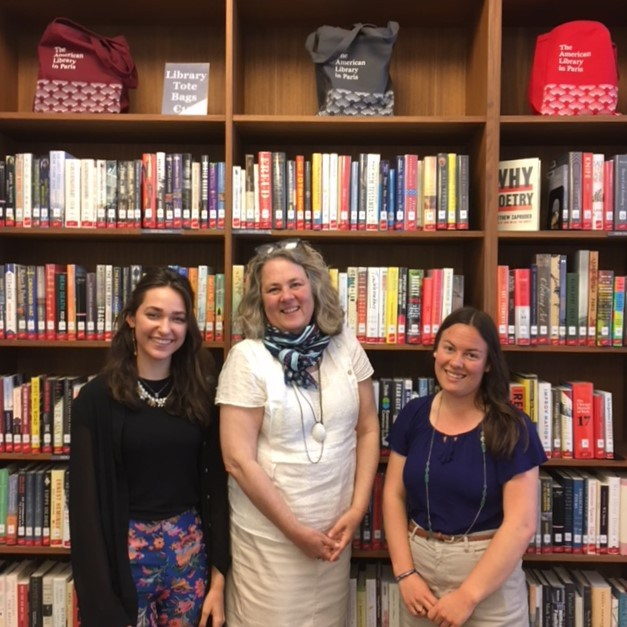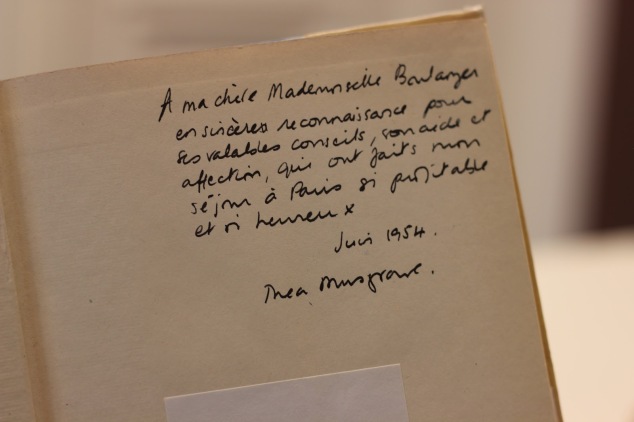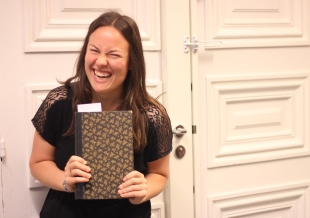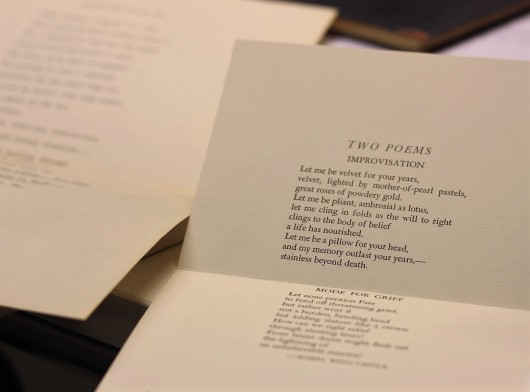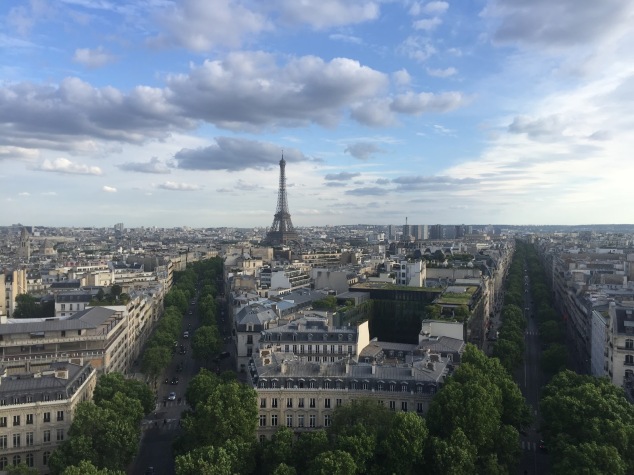
View of the city from the Arc de Triomphe; photo by Hannah Jones
~ Natalie Dykstra, Professor of English
We are coming to the close of our second week at the American Library in Paris – and what adventures we’ve had! Hannah and Aine are finalizing their project on Janet Flanner. They wrote a lengthy finding aid, which records all the details related to Flanner’s books that had been donated to the library in 1983. This finding aid, which will be available on the library’s website (and via this blog), will make it possible for library patrons and researchers to understand more fully this important American writer. Also, stay tuned to this space for their report on fascinating discoveries of an earlier link between the library and Hope College.
Kelly Jacobsma brought all her expertise to our work, particularly her skill and patience with archival sources. I marvel. She also visited the nearby American University in Paris Quai d’Orsay Student Life and Learning Commons, a library that, until recently, shared space with the American Library in Paris. She writes about her visit below.
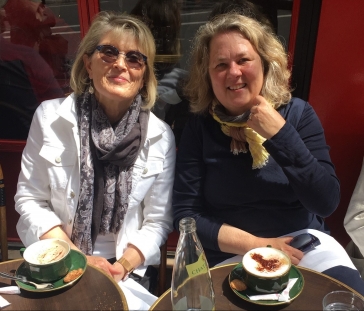
Kelly and Natalie
There is something powerful about collaborative work with colleagues and students – you can go farther as a team than on one’s own. I’m delighted to have had the chance to work with such stellar group!
A special thanks Abigail Altman, assistant director of the library, for fascilitating our time here – we look forward to continuing our partnership to tell these fascinating Paris stories. Thank you to Mellon Grand Challenges, Paris Stories teammates Lauren Janes and Heidi Kraus, and Hope College for their on-going and generous support.
~ Hannah Jones ’21 and Aine O’Connor ’20
We can hardly believe our time in Paris and at the American Library is coming to an end. It feels both like we just got here and like we’ve been living here forever. It’s been a transformative experience. We are very fortunate to have worked in this historical institution and are thankful for the warm welcome we received from Abigail Altman (Assistant Director) and all the librarians here. It’s been an honor to continue the relationship between the American Library and Hope College, one that began much earlier than we’d previously thought.
We would like to especially thank Dr. Natalie Dykstra for inviting us to be a part of Archive Stories. She greatly assisted us in defining what our project would look like and provided mentorship on completing a finding aid and conducting cross-cultural research. We are also indebted to Kelly Jacobsma, Genevra Thome Begg Dean of Libraries, for her archival and research expertise.
Our project on Janet Flanner has been a joyful dive into archives and good books. Notes from friends and admirers, tucked away in Janet’s book collection, have now been uncovered, allowing us to bring a story to life in a new way. It has been a privilege to rediscover and retell her incredibly interesting and intricate life.
Arriving at the library, we weren’t sure what to expect. Traveling abroad to a country where the language is not your own can be an isolating experience, so the library ended up providing a welcome respite from navigating the unfamiliar culture of France. The library understands the need to find a home in a new place. As a place founded for soldiers to be able to read books while fighting in World War I, there is a deep respect for the power of literature in times of confusion. There is a magic here that cannot really be described; it demands to be experienced firsthand.
Thank you to Dr. Lauren Janes and Dr. Heidi Kraus, directors of the Paris May Term, for their enthusiasm for and knowledge of French culture and willingness to include us in their activities. We are grateful to Abigail Altman and the rest of the staff at the library for this wonderful experience. Finally, Mellon Grand Challenges supported this opportunity to go to Paris and work at the library; we are honored and delighted to represent their work.
Hannah: I have dreamed of going to Paris since I was very young. I took six years of French class, made bucket lists of what I would someday see, and imagined all of the delicious foods I would taste. (Seriously, the food here in France is unbelievable. I don’t know what I’m going to do when I get back home.) Even so, despite all of my “somedays,” the idea of actually being in Paris never fully felt real to me. Being here, as cheesy as it sounds, is literally my dream come true. This city is everything I hoped it would be– breathtakingly beautiful, continously loud, and rich with history and culture. Not a day has gone by that I haven’t grabbed Aine’s arm and exclaimed something along the lines of, “Look at that building over there. We’re in Paris. Can you believe it?”
There is a sort of paradox about Paris. It has a population of over two million people, yet it is also somehow so personal. Aine and I were fortunate to find a lovely bakery near our apartment which quickly became part of our routine. Each day after work, we would 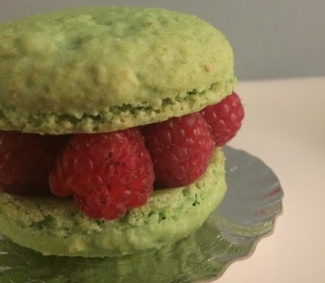 stop by the bakery, be greeted by the friendly employees, and order breakfast for the next morning (croissants or pain au chocolats) and a new dessert to try that evening (my personal favorite was the amarys pistache framboise, a pistachio macaron filled with cream and fresh raspberries). And although there are two million people who have places to be, the city has a slower pace than I had anticipated. Yes, people run through the metro stations, but there is also an emphasis on taking time to enjoy a coffee with friends, on simply visiting with people and enjoying good food. Things are done deliberately in Paris.
stop by the bakery, be greeted by the friendly employees, and order breakfast for the next morning (croissants or pain au chocolats) and a new dessert to try that evening (my personal favorite was the amarys pistache framboise, a pistachio macaron filled with cream and fresh raspberries). And although there are two million people who have places to be, the city has a slower pace than I had anticipated. Yes, people run through the metro stations, but there is also an emphasis on taking time to enjoy a coffee with friends, on simply visiting with people and enjoying good food. Things are done deliberately in Paris.
Aine: Paris was never supposed to be my place. It was my sister who took French and my mother who loved French food. They visited Paris many years ago, and that appeared to wrap up my family’s French travels, because why would they need to go back? The City of Light seemed hazy to me, like a distant dream that would probably never be realized. If you had told me as I began my college career that my study abroad experience would be here, I would have thought you were crazy.
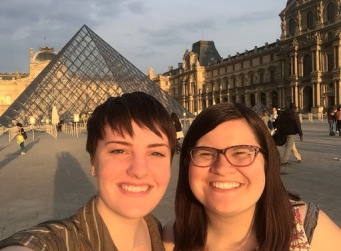
Hannah and Aine – Golden Hour at the Louvre
Yet, here I am. Paris, in many ways, has become mine, a place I could now show around to someone else. I could tell them about how to avoid the vendors at the Eiffel Tower or the best place to get cassoulet. I could introduce them to the magnificent Huré bakery and enjoy a pain au chocolat with them in the morning. I could even demonstrate how to push through the most crowded Metro train ever to get off at the right stop. These tiny things, the secrets of living in Paris, are my favorite part of being here. There is so much satisfaction in conquering the small struggles that seem so difficult in the moment and so easy in retrospect. Traveling abroad is the best mix of challenge and contentment that I’ve ever experienced. Hannah has actually wanted to go to Paris far longer than I have, and so seeing the city become hers just as much as mine is the greatest joy. I’ve loved every moment of being here together, and I can’t wait to see how the growth I’ve experienced in Paris continues to make me feel stronger, more grown-up, and also (always) more curious about what the world can hold.
***
~ Kelly Jacobsma, Dean of Hope College Libraries
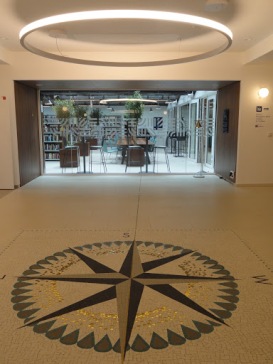 Monday I was privileged to spend the day at the American University in Paris Quai d’Orsay Student Life and Learning Commons, which just opened this spring. I met with Constance Paris de Bollardiere, historian and archivist at the George and Irina Schaeffer Center for the Study of Genocide, Human Rights and Conflict Prevention. The American University in Paris is one of several sites world-wide that provides access the University of Southern California Shoah Foundation Visual History Archive which allows users to search through and view more than 54,000 video testimonies of survivors and witnesses of genocide. The majority of the testimonies are from Holocaust survivors, but more recently the collection has been expanded to include Armenian Genocide, massacres in China and Cambodia and Genocide against the Tutsi in Rwanda. Some of the testimonies are available to the public online, but to view the majority of the collection you need to visit one of the hosting archives.
Monday I was privileged to spend the day at the American University in Paris Quai d’Orsay Student Life and Learning Commons, which just opened this spring. I met with Constance Paris de Bollardiere, historian and archivist at the George and Irina Schaeffer Center for the Study of Genocide, Human Rights and Conflict Prevention. The American University in Paris is one of several sites world-wide that provides access the University of Southern California Shoah Foundation Visual History Archive which allows users to search through and view more than 54,000 video testimonies of survivors and witnesses of genocide. The majority of the testimonies are from Holocaust survivors, but more recently the collection has been expanded to include Armenian Genocide, massacres in China and Cambodia and Genocide against the Tutsi in Rwanda. Some of the testimonies are available to the public online, but to view the majority of the collection you need to visit one of the hosting archives.
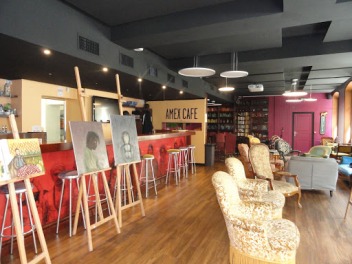 The American University in Paris just recently moved into a newly renovated building along the Seine that houses a learning commons including the library, writing center, academic support center, student development and a cafe. University Librarian, Jorge Sosa graciously gave me a tour and explained the concept behind the renovated spaces. Space everywhere in Paris is at a premium and the design of this library is a future forward design that integrates library staff and student spaces. The most innovated part of the design (which may have been from necessity due to space concerns) is that library staff offices are housed on each floor next to student learning spaces and study rooms. Offices are very visually accessible and students are used to asking for help from whoever is closest at hand.
The American University in Paris just recently moved into a newly renovated building along the Seine that houses a learning commons including the library, writing center, academic support center, student development and a cafe. University Librarian, Jorge Sosa graciously gave me a tour and explained the concept behind the renovated spaces. Space everywhere in Paris is at a premium and the design of this library is a future forward design that integrates library staff and student spaces. The most innovated part of the design (which may have been from necessity due to space concerns) is that library staff offices are housed on each floor next to student learning spaces and study rooms. Offices are very visually accessible and students are used to asking for help from whoever is closest at hand.
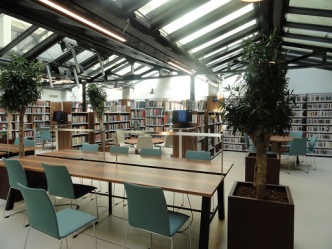 Now that the library renovation is complete, they are turning their attention to migrating their library management system to Alma and Primo, which the Hope library did last summer. Our interests and concerns about running a small academic library are very similar and conversation ranged from learning commons design and compact shelving to the importance of information literacy and how it is integrated into their first year seminar course, which they call First Bridge. The American University in Paris is a member of the Global Liberal Arts Alliance, of which Hope College is a member.
Now that the library renovation is complete, they are turning their attention to migrating their library management system to Alma and Primo, which the Hope library did last summer. Our interests and concerns about running a small academic library are very similar and conversation ranged from learning commons design and compact shelving to the importance of information literacy and how it is integrated into their first year seminar course, which they call First Bridge. The American University in Paris is a member of the Global Liberal Arts Alliance, of which Hope College is a member.
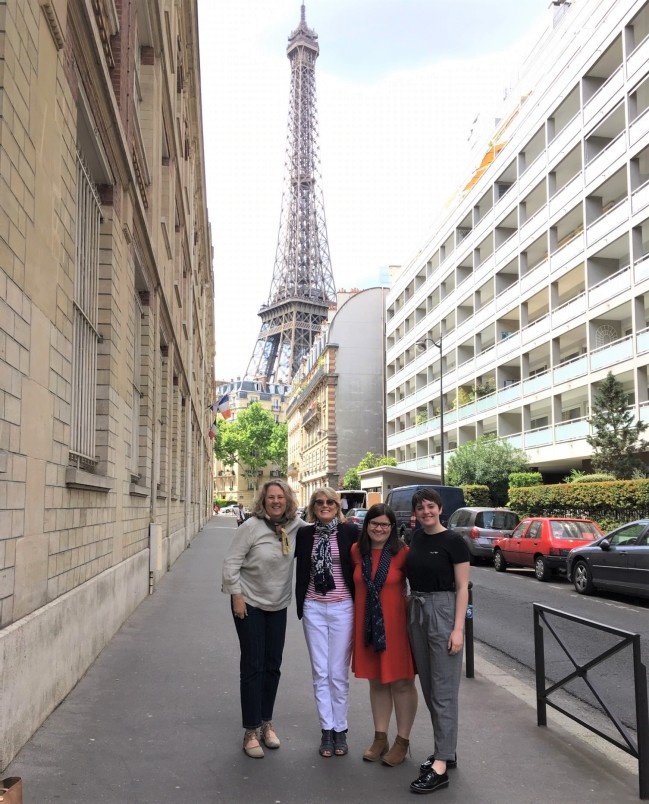
May 2019 Archive Stories|Paris Stories Team
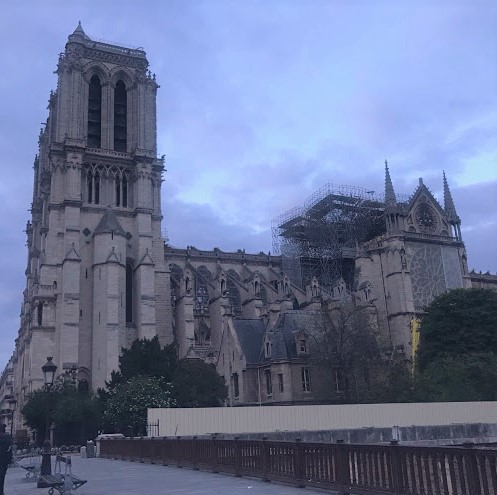
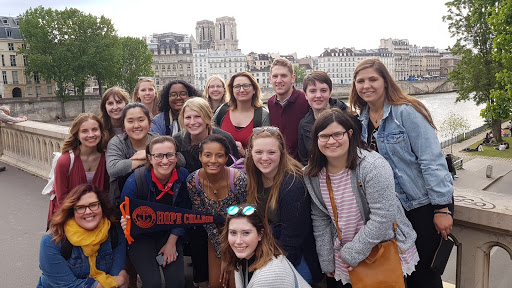
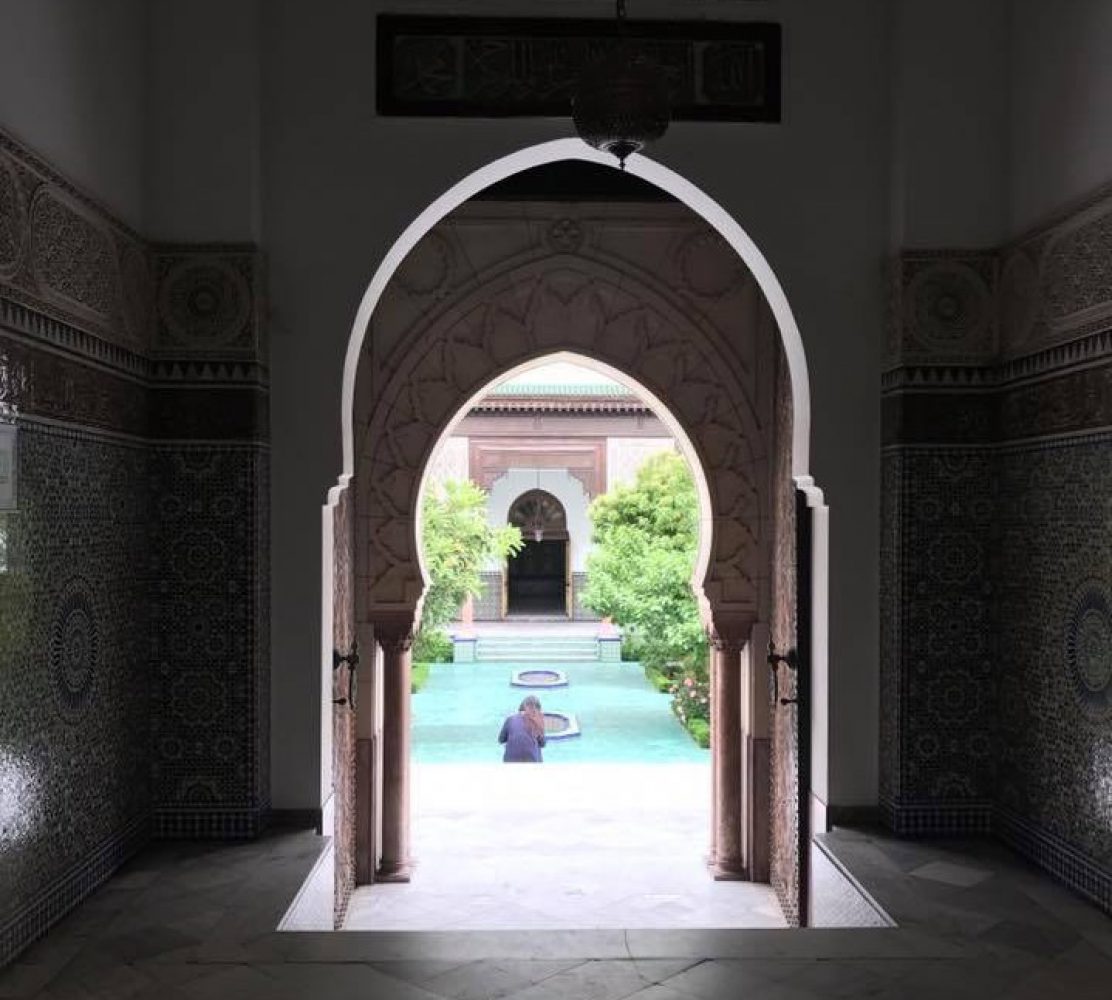


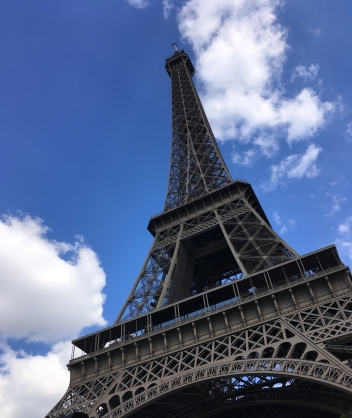




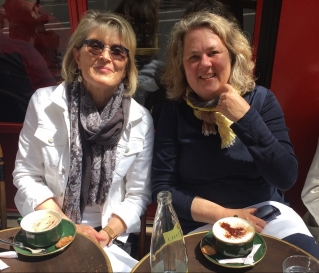



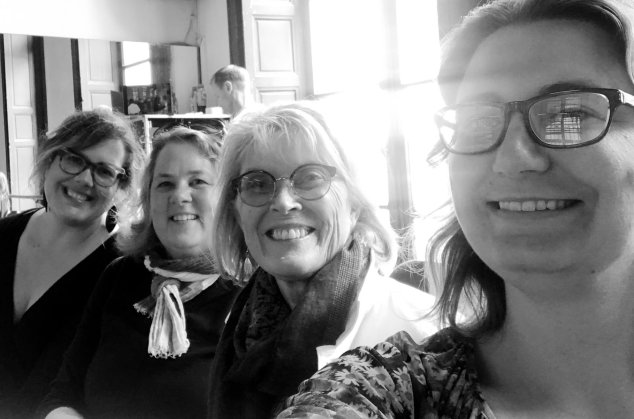











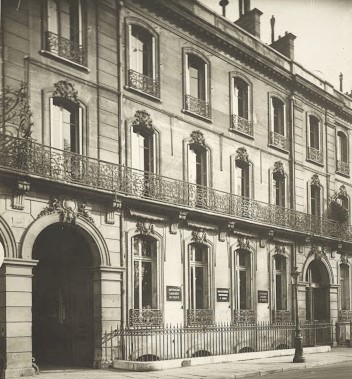
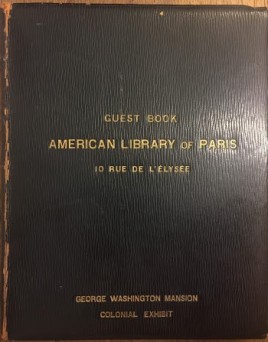 When Dr. Natalie Dykstra and Abigail Altman, the Assistant Director at the American Library in Paris (ALP), began working together in the summer of 2017, they had no idea there was evidence of a relationship between Hope College and the library dated sixty years ago this month. In late 2018, Altman discovered an old American Library guest book. Mid-way through the pages listing the usual galas and fundraising events are two pages, with a list of signatures, for a reception held for Hope College students at the library on June 16, 1959, sixty years ago this week. Forty-six students and faculty from Hope attended. There are no other events listing college students in the guestbook, only Hope College. Seeing this evidence of an earlier relationship, a record of which was found in a miscellaneous box in the library’s archives, sent a shiver down our spines. How did these two institutions, 4,000 miles apart, find each other not once, but
When Dr. Natalie Dykstra and Abigail Altman, the Assistant Director at the American Library in Paris (ALP), began working together in the summer of 2017, they had no idea there was evidence of a relationship between Hope College and the library dated sixty years ago this month. In late 2018, Altman discovered an old American Library guest book. Mid-way through the pages listing the usual galas and fundraising events are two pages, with a list of signatures, for a reception held for Hope College students at the library on June 16, 1959, sixty years ago this week. Forty-six students and faculty from Hope attended. There are no other events listing college students in the guestbook, only Hope College. Seeing this evidence of an earlier relationship, a record of which was found in a miscellaneous box in the library’s archives, sent a shiver down our spines. How did these two institutions, 4,000 miles apart, find each other not once, but 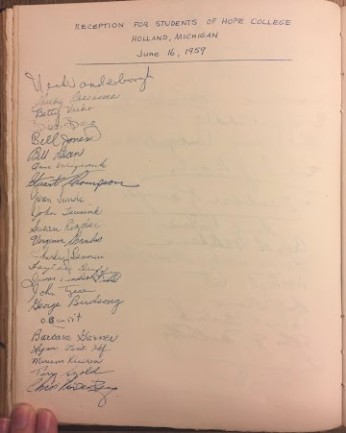
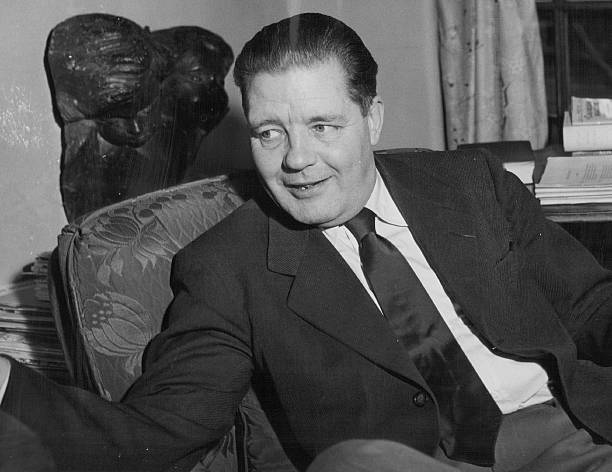


 stop by the bakery, be greeted by the friendly employees, and order breakfast for the next morning (croissants or pain au chocolats) and a new dessert to try that evening (my personal favorite was the amarys pistache framboise, a pistachio macaron filled with cream and fresh raspberries). And although there are two million people who have places to be, the city has a slower pace than I had anticipated. Yes, people run through the metro stations, but there is also an emphasis on taking time to enjoy a coffee with friends, on simply visiting with people and enjoying good food. Things are done deliberately in Paris.
stop by the bakery, be greeted by the friendly employees, and order breakfast for the next morning (croissants or pain au chocolats) and a new dessert to try that evening (my personal favorite was the amarys pistache framboise, a pistachio macaron filled with cream and fresh raspberries). And although there are two million people who have places to be, the city has a slower pace than I had anticipated. Yes, people run through the metro stations, but there is also an emphasis on taking time to enjoy a coffee with friends, on simply visiting with people and enjoying good food. Things are done deliberately in Paris.
 Monday I was privileged to spend t
Monday I was privileged to spend t The American University in Paris just recently moved into a newly renovated building along the Seine that houses a learning commons including the library, writing center, academic support center, student development and a cafe. University Librarian, Jorge Sosa graciously gave me a tour and explained the concept behind the renovated spaces. Space everywhere in Paris is at a premium and the design of this library is a future forward design that integrates library staff and student spaces. The most innovated part of the design (which may have been from necessity due to space concerns) is that library staff offices are housed on each floor next to student learning spaces and study rooms. Offices are very visually accessible and students are used to asking for help from whoever is closest at hand.
The American University in Paris just recently moved into a newly renovated building along the Seine that houses a learning commons including the library, writing center, academic support center, student development and a cafe. University Librarian, Jorge Sosa graciously gave me a tour and explained the concept behind the renovated spaces. Space everywhere in Paris is at a premium and the design of this library is a future forward design that integrates library staff and student spaces. The most innovated part of the design (which may have been from necessity due to space concerns) is that library staff offices are housed on each floor next to student learning spaces and study rooms. Offices are very visually accessible and students are used to asking for help from whoever is closest at hand. Now that the library renovation is complete, they are turning their attention to migrating their library management system to Alma and Primo, which the Hope library did last summer. Our interests and concerns about running a small academic library are very similar and conversation ranged from learning commons design and compact shelving to the importance of information literacy and how it is integrated into their first year seminar course, which they call First Bridge. The American University in Paris is a member of the Global Liberal Arts Alliance, of which Hope College is a member.
Now that the library renovation is complete, they are turning their attention to migrating their library management system to Alma and Primo, which the Hope library did last summer. Our interests and concerns about running a small academic library are very similar and conversation ranged from learning commons design and compact shelving to the importance of information literacy and how it is integrated into their first year seminar course, which they call First Bridge. The American University in Paris is a member of the Global Liberal Arts Alliance, of which Hope College is a member.
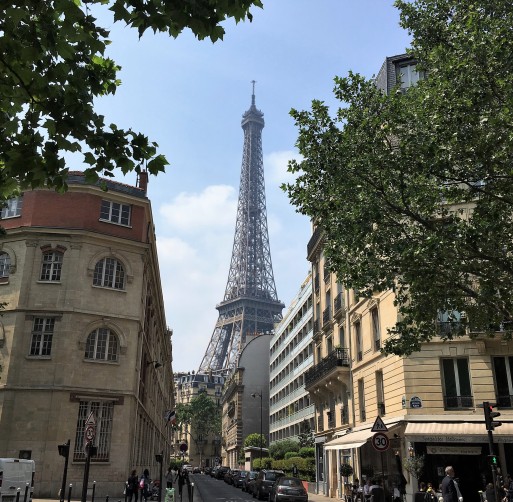
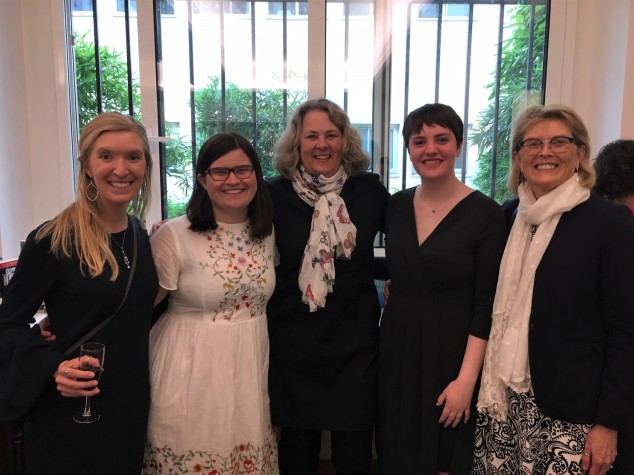
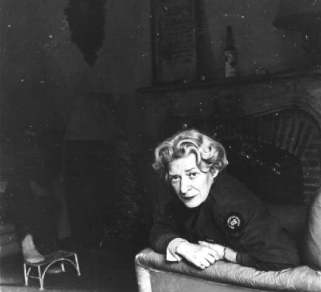
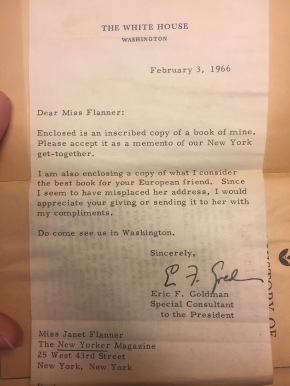
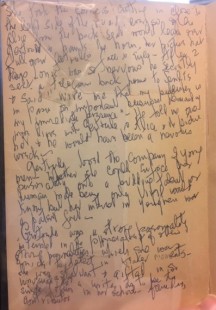
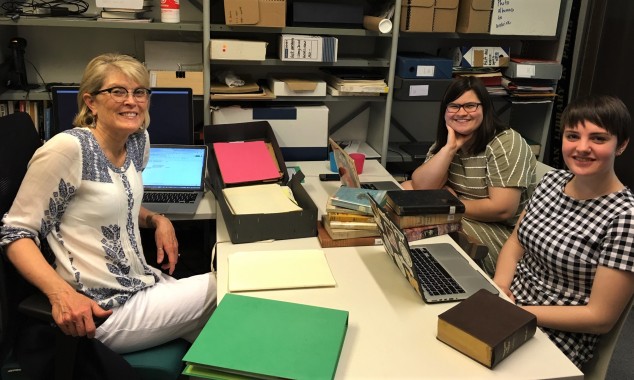 When I arrived at the library, Aine and Hannah were well underway on the Flanner project and had already made several interesting discoveries. Abigail Altman, Assistant Director in charge of the library’s archives and special collections, provided a lot of historical background and context for the collections. The ALP is a hybrid between an extremely busy modern public library and an academic-type library serving American college and French students. The conference room was filled all afternoon with high school age students working collaboratively and studying for exams.
When I arrived at the library, Aine and Hannah were well underway on the Flanner project and had already made several interesting discoveries. Abigail Altman, Assistant Director in charge of the library’s archives and special collections, provided a lot of historical background and context for the collections. The ALP is a hybrid between an extremely busy modern public library and an academic-type library serving American college and French students. The conference room was filled all afternoon with high school age students working collaboratively and studying for exams.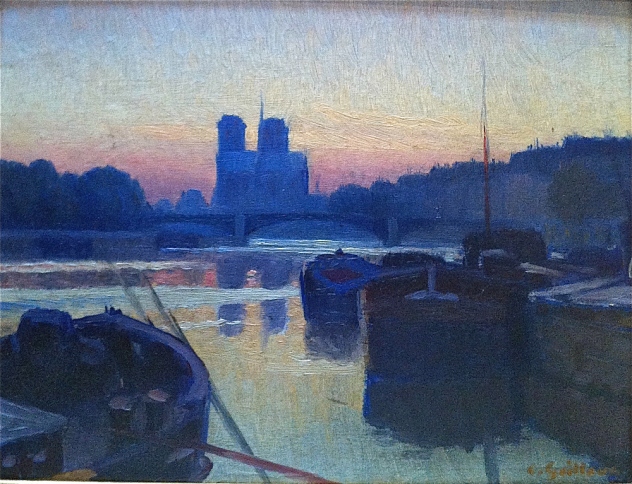
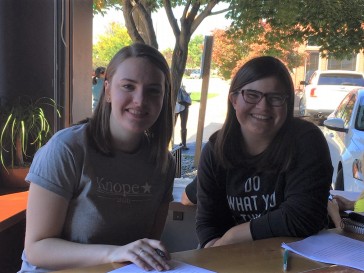
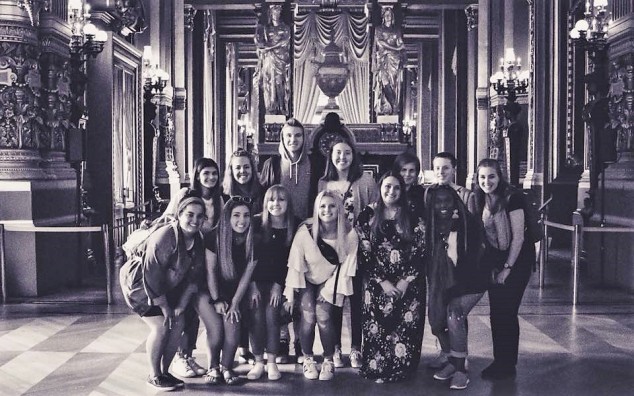 Recruiting has started for the 2019 Art, History, and Global Citizenship Paris May Term at Hope College! (Apply
Recruiting has started for the 2019 Art, History, and Global Citizenship Paris May Term at Hope College! (Apply 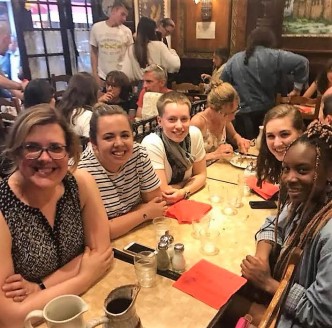
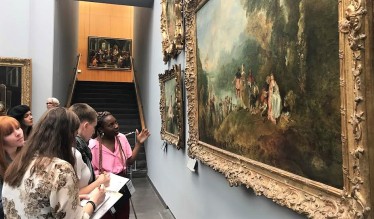 Kelly Ocock (Studio Art, ‘19) and Merrit Kramer (Business, 2021) analyze Marc Chagall’s “Derrière le village,” 1916, as they observed it in the “Chagall, Lissitzky, Malévitch: The Russian Avant-Garde in Vitebsk (1918-1922)” exhibition at the
Kelly Ocock (Studio Art, ‘19) and Merrit Kramer (Business, 2021) analyze Marc Chagall’s “Derrière le village,” 1916, as they observed it in the “Chagall, Lissitzky, Malévitch: The Russian Avant-Garde in Vitebsk (1918-1922)” exhibition at the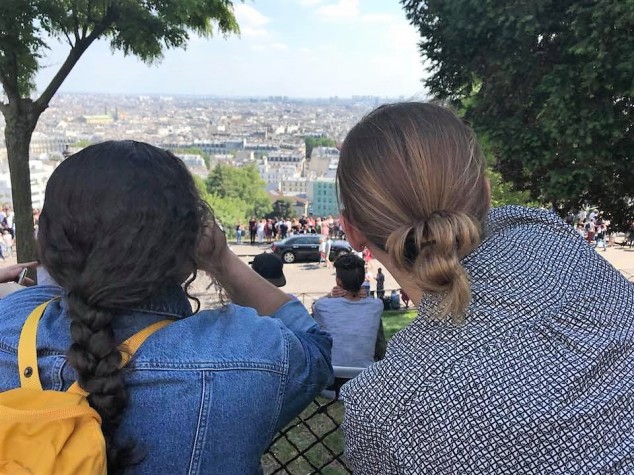
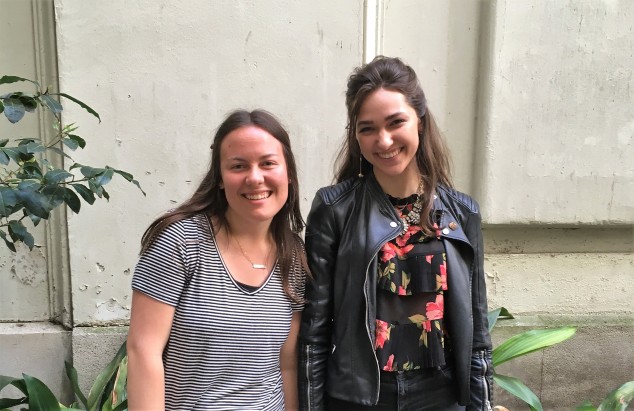
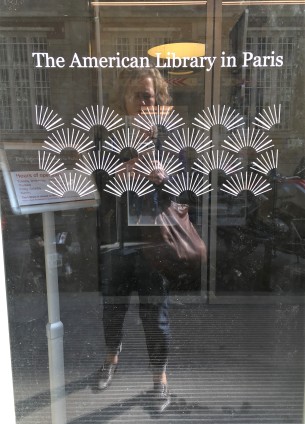 I’m enormously proud of the work accomplished by Sarah and Michaela, which they showcase in their project website, entitled
I’m enormously proud of the work accomplished by Sarah and Michaela, which they showcase in their project website, entitled 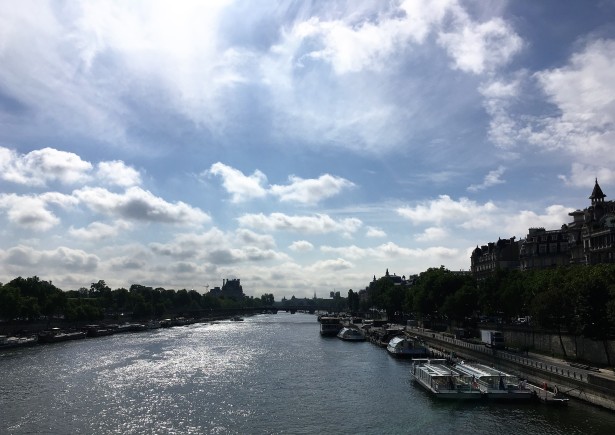

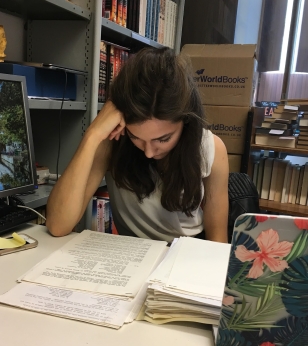
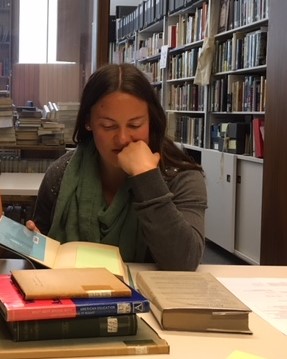 Returning to the French capital this May was exciting for several reasons— it reminded me of the memories I made and the lessons I learned on my last visit here in 2016, during the Paris May term, but also gave me the chance to see this city in new ways. Since it also comes at the end of a semester spent abroad in Nantes, France, this time in Paris was a way to celebrate what I’ve learned about French language, history, and culture while discovering more about what it means to do archive work. The French take moments in their day to socialize around a cup of coffee and spend time in nature, yet they still get their work done. By embracing a bit of this way of life during my studies, I’m appreciating how living abroad (even for a short amount of time) can be an opportunity for growth that won’t end upon my arrival back home.
Returning to the French capital this May was exciting for several reasons— it reminded me of the memories I made and the lessons I learned on my last visit here in 2016, during the Paris May term, but also gave me the chance to see this city in new ways. Since it also comes at the end of a semester spent abroad in Nantes, France, this time in Paris was a way to celebrate what I’ve learned about French language, history, and culture while discovering more about what it means to do archive work. The French take moments in their day to socialize around a cup of coffee and spend time in nature, yet they still get their work done. By embracing a bit of this way of life during my studies, I’m appreciating how living abroad (even for a short amount of time) can be an opportunity for growth that won’t end upon my arrival back home.